Photographs: Reuters Business Standard
Given the Reserve Bank of India’s recent credit squeeze and the likelihood of rising inflation due to the weaker rupee, the environment will be more challenging in the second quarter of 2013-14.
Until last Saturday, 399 listed companies from across manufacturing, as well as banking and finance, reported results for the first quarter of this financial year (2013-14).
The numbers suggest that India Inc is still struggling for growth momentum and may, in fact, have lost some ground.
The total operating income of the sample was Rs 3.88 lakh crore (Rs 3.88 trillion).
Sales have grown by four per cent over April-June 2012, while profit after tax has grown by five per cent -- the lowest growth rates in the past five quarters.
Allowing for wholesale inflation, which ran at just below five per cent, the results indicate stagnation.
This impression is reinforced by operating profits (profit before depreciation, interest and tax), which have grown at 7.7 per cent for the whole sample, and at 4.6 per cent for non-financial enterprises -- again, the lowest growth in the last five quarters.
. . .
India's economic crisis: No daylight yet
Photographs: Ajay Verma/Reuters
Operating margins growth has, however, held steady at 19 per cent.
The quality of earnings may have deteriorated since other income rose by 23 per cent.
Manufacturing looks to be in deep trouble.
The 330-company sample of non-financial enterprises showed net sales growth of two per cent, with the growth in profit after tax showing even lower at 1.5 per cent.
Both consumption demand and investment have collapsed -- the sample covers the entire value chain from capital goods and commodities to finished products and services such as hospitality and information technology.
The financial sector and banks did better, as net interest margins increased.
. . .
India's economic crisis: No daylight yet
Image: A vender sells Indian national flags to his customers at a shop in Siliguri. National flags are in big demand during Independence Day celebrations.Photographs: Rupak De Chowdhuri/Reuters
Lower inflation was also beneficial in that raw material costs declined by 6.7 per cent and power costs, including fuel costs, fell by 2.5 per cent.
Employee compensation, however, ballooned by 16 per cent.
Given that employment did not expand, this reflects attempts to retain skilled labour, of which there is an endemic shortage.
Among specific sectors, information technology firms have done well due to the weak rupee.
Software firms saw a 15 per cent rise in revenues and a nine per cent rise in after-tax profit.
. . .
India's economic crisis: No daylight yet
Image: A worker is seen through a flag as he gives finishing touches to an Indian flag at a workshop in Siliguri.Photographs: Rupak De Chowdhuri/Reuters
Non-banking financial companies have also done well -- they have recorded 22 per cent revenue expansion and a 33 per cent rise in after-tax profit.
Banks have done reasonably well, with nine per cent revenue growth and a 10 per cent rise in profit after tax.
Textiles have also recorded a reasonably healthy performance -- there has been a 10 per cent rise in sales and an 18 per cent increase in after-tax profit.
But the good news ends there.
Both the automobiles and auto ancillary industries saw shrinking top lines and bottom lines.
Capital goods firms have seen a 15 per cent drop in profit after tax on nominally lower income.
Infrastructure has seen a 12 per cent drop in after-tax profit.
. . .
India's economic crisis: No daylight yet
Image: A boy attends Independence Day celebrations at a school in a slum area in Siliguri.Photographs: Rupak De Chowdhuri/Reuters
Cement saw a three per cent drop in revenues and a big 45 per cent dip in profit after tax. Fast-moving consumer goods (aside from ITC) recorded revenue growth at five per cent and their profit after tax was down 12 per cent.
Given the Reserve Bank of India’s recent credit squeeze and the likelihood of rising inflation due to the weaker rupee, the environment will be more challenging in the second quarter of 2013-14.
In particular, banks and financial companies will be stretched to maintain net interest margins, while interest rate-sensitive businesses with high working capital requirements will also be under pressure.
There doesn’t seem to be daylight at the end of the tunnel yet.

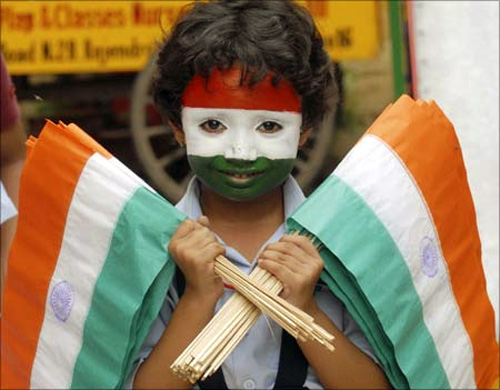
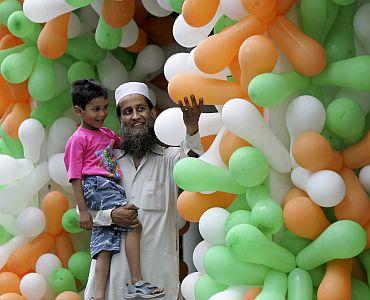
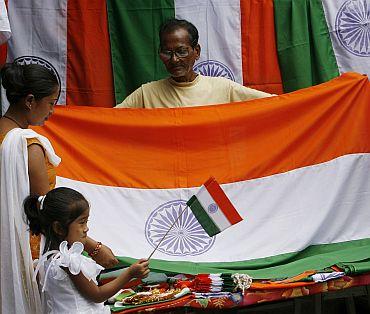
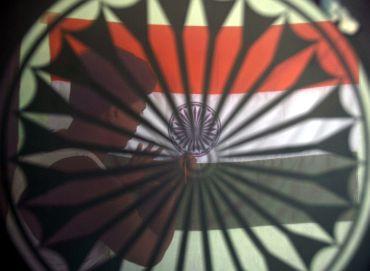
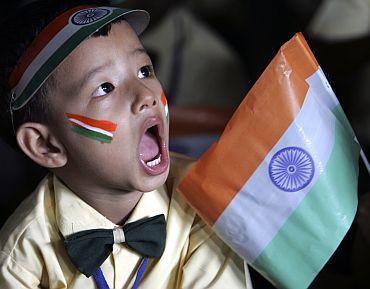

article